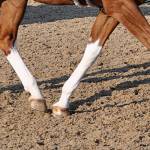New Tool Helps Horse Owners Recognize Lameness

Subtle lameness can be challenging for horse owners to diagnose. With this in mind, veterinary specialists recently developed a tool to help owners recognize unsoundness.
The tool, called a Ridden Horse Pain Ethogram (RHpE), uses 24 behaviors to identify unsoundness. Those behaviors were shown to be 10 times more likely in lame horses. Further, when diagnostic anesthesia (e.g., nerve or joint block) was used to abolish pain, those behaviors diminished.
Examples of behaviors in the RHpE include:
- Changes in head position during movement;
- Ears rotated back or laid flat;
- Eyelids closed, frequent blinking, whites of eyes exposed repeatedly, or a glazed expression;
- Frequent mouth-opening, protruding tongue, bit pulled through the mouth from one side to another;
- Tail-swishing during transitions or clamping tail;
- Abnormal changes in gait, stumbling, irregular rhythms, changes in speed; and
- Reluctance to move, rearing, or bucking.
To develop the RHpE, horses under saddle were examined and video-recorded while performing at the walk, trot, and canter. Based on the observance of those behaviors, a numeric scale was applied. Scores of 8 or higher on the 24-point scale reflected the presence of musculoskeletal pain.
When the RHpE was applied to a group of 60 sporthorses and riding school horses, 73% exhibited low-grade lameness on one or more limbs (lameness grade 2 or less on an 8-point scale). RHpE scores ranged from 3 to 16, with a median score of 9 out of 24.
“The behaviors included in the RHpE should be considered a sign of chronic discomfort rather than normal behavior in pain-free horses. Once these behaviors are recognized as abnormal, then lameness can be addressed, improving the horse’s welfare and performance,” advised Kathleen Crandell, Ph.D., of Kentucky Equine Research.
Be cautious about jumping into using the RHpE, though. According to the researchers, “education of owners, riders, trainers, and all associated professionals is required about what constitutes abnormal horse behavior, so that lame horses are recognized and undergo appropriate investigation and treatment, in order to both enhance equine welfare and improve performance.”
Crandell recognizes the value in the RHpe but echoes these cautions.
“I think the ethogram could potentially be a useful tool, but it requires some skill, particularly since an ill-fitting saddle or a lack of rider skill could potentially affect the accuracy of the ethogram. For now, it is perhaps more a tool for veterinarians with the appropriate training than the average horse owner, so it would be a good idea to have a proper veterinary evaluation if a rider felt the horse was exhibiting too many of the signs laid out in the ethogram. Further, all the research has been done with horses in English saddles and on the bit, so the ethogram would need some adaptations to be useful for evaluating lameness in horses involved in other riding disciplines,” explained Crandell.
Be sure to protect joints from inflammation that can expedite the development of osteoarthritis. Kentucky Equine Research offers several joint supplements as well as omega-3 fatty acids that can be used in isolation or in concert to slow the development and progression of disease.
*Dyson, S., and D. Pollard. 2020. Application of a ridden horse pain ethogram and its relationship with gait in a convenience sample of 60 riding horses. Animals (Basel) 10(6):E1044.








